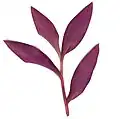Tradescantia pallida
Tradescantia pallida is a species of spiderwort native to the Gulf Coast region of eastern Mexico. The cultivar T. pallida 'Purpurea' is commonly called purple secretia, purple-heart,[2] or purple queen.[3] Edward Palmer collected the type specimen near Ciudad Victoria, Tamaulipas in 1907.[4][5]
| Tradescantia pallida | |
|---|---|
 | |
| Tradescantia pallida 'Purpurea' | |
| Scientific classification | |
| Kingdom: | Plantae |
| Clade: | Tracheophytes |
| Clade: | Angiosperms |
| Clade: | Monocots |
| Clade: | Commelinids |
| Order: | Commelinales |
| Family: | Commelinaceae |
| Genus: | Tradescantia |
| Species: | T. pallida |
| Binomial name | |
| Tradescantia pallida | |
| Synonyms[1] | |
|
Setcreasea pallida Rose | |
Names
The Latin specific epithet pallida means "pale".[6]
Description
Tradescantia pallida is an evergreen perennial plant of a scrambling, climbing growth habit and vine-like stature. Small aerial roots will form along the stem, which root the vine further in-place and give greater stamina to the overall plant body. It is distinguished by vivid purple, elongated and slightly pointed leaves - generally a glaucous green, turning more vividly purple in full sunlight and times of drought - and bearing small, three-petaled flowers of white, pink or purple. Plants are susceptible to overwatering, moderate frosts, or any temperature below about 40°F (4.44°C); in times of cold-induced seasonal die-back, the rootball will remain sheltered underground, eventually sprouting again from the base.[7] In the coldest of regions, deadheading, fall pruning, mulching and placing the rootball just slightly higher than the planting hole—to ensure that pooling water beneath the roots is not a threat—are all key to the plant surviving cold and/or wet conditions.
The cultivar T. pallida 'Purpurea' has purple leaves and pink flowers.
Cultivation
Widely used as an ornamental plant in gardens and borders, as a ground cover, hanging plant, or - particularly in colder climates where it cannot survive the winter season - houseplant, it is propagated easily by cuttings (the stems are visibly segmented and roots will frequently grow from the joints).
As a houseplant, T. pallida has been judged exceptionally effective at improving indoor air quality by filtering out volatile organic compounds, a class of common pollutants and respiratory irritants, an effect known as phytoremediation.[8]
Numerous cultivars are available, of which 'Purpurea' with purple foliage has gained the Royal Horticultural Society's Award of Garden Merit.[9][10]
Gallery
 Leaves, superior aspect
Leaves, superior aspect
(T. pallida 'Purpurea') Leaves, inferior aspect
Leaves, inferior aspect
(T. pallida 'Purpurea') Flower
Flower
(T. pallida 'Purpurea') Close-up shot of flower
Close-up shot of flower
(T. pallida 'Purpurea') Feral Tradescantia pallida growing in the sidewalk in Patra, Greece.
Feral Tradescantia pallida growing in the sidewalk in Patra, Greece.
References
- "Tradescantia pallida". Germplasm Resources Information Network. Agricultural Research Service, United States Department of Agriculture. Retrieved 2011-11-20.
- BSBI List 2007 (xls). Botanical Society of Britain and Ireland. Archived from the original (xls) on 2015-06-26. Retrieved 2014-10-17.
- USDA, NRCS (n.d.). "Tradescantia pallida". The PLANTS Database (plants.usda.gov). Greensboro, North Carolina: National Plant Data Team. Retrieved 14 December 2015.
- "Tradescantia pallida". EOL. Retrieved 24 March 2018.
- "Tradescantia pallida" at the Encyclopedia of Life
- Harrison, Lorraine (2012). RHS Latin for Gardeners. United Kingdom: Mitchell Beazley. ISBN 978-1845337315.
- Duever, Linda Conway (2006-08-31). "#734 Tradescantia pallida". Floridata.
- Yang, Dong Sik, Pennisi, Svoboda V., Son, Ki-Cheol, Kays, Stanley J. Screening Indoor Plants for Volatile Organic Pollutant Removal Efficiency. HortScience, Published online 1 August 2009; in print 44: 1377-1381 (2009)
- "Tradescantia pallida 'Purpurea'". RHS. Retrieved 5 March 2021.
- "AGM Plants - Ornamental" (PDF). Royal Horticultural Society. July 2017. p. 102. Retrieved 24 December 2018.
External links
 Media related to Tradescantia pallida at Wikimedia Commons
Media related to Tradescantia pallida at Wikimedia Commons Data related to Tradescantia pallida at Wikispecies
Data related to Tradescantia pallida at Wikispecies- Purple heart, Wandering Jew at Desert Tropicals